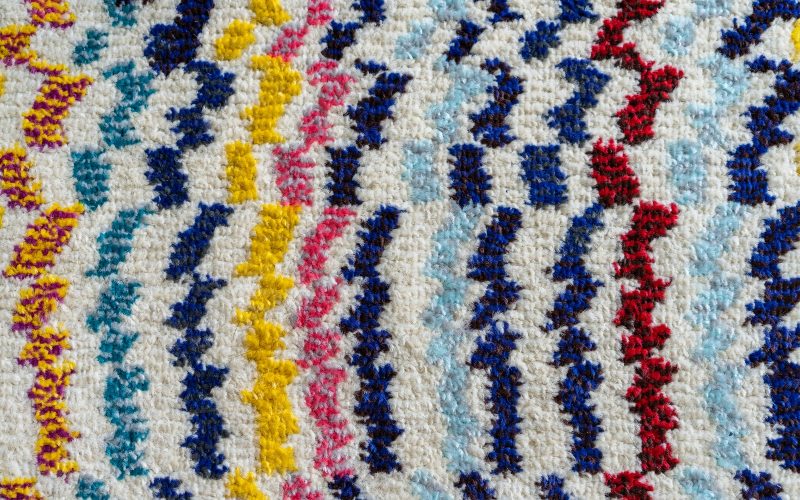If you’re new to rug shopping, it’s easy to feel overwhelmed by all the different types of rug materials—and the hefty price tags attached to many of them—.
Style, placement, and price are the three main factors to consider when choosing a rug.
You might also want to consider how simple it is to clean the rug, how long you plan to keep it, and whether you prefer particular materials.
Understanding the various types of rug materials is crucial before considering your area rug’s design.
Continue reading this article as we discuss the different types of rug materials in the market.
1. Wool
Wool rugs are typically handwoven, hand-tufted, hand-knotted, or hand-loomed. Wool rugs made on machines are also made of wool, but they are usually synthetic rather than actual wool.
Due to the extensive work involved in designing and creating them. Authentic wool rugs are more expensive, but the quality is excellent.
Also, wool rugs are frequently passed down from generation to generation, making them a wise investment as heirlooms.
Because of its durability, this kind of rug is perfect for high-traffic areas like the living room, bedroom, and entryway.
Imagine a rug that is as luxurious and comfortable as your go-to sweater. Thanks to the luxuriously soft wool pile, you can lounge barefoot anywhere in your house.
Also, wool’s dense fibers are crush-resistant. So they will recover over time, even in a home with boisterous children and pets.
Furthermore, you should consider the quality of the Highland-resistant wool if you prioritize easy-to-clean construction.
An area rug made from sheep’s wool will remain thick and plush. It is colorful in areas with heavy traffic because sheep’s natural oils repel water, dust, and dirt.
2. Silk
Silk rugs are lovely and elegant, offering an opulent sheen and graceful softness. Silk is also delicate and incredibly decorative, so you’ll want to flaunt it.
However, low-traffic areas are where it works best. A 100% silk rug needs more maintenance than other rug materials due to its shimmer.
Also, combined wool and silk rug fibers can provide the same dramatic appearance as silk while being more durable and straightforward to maintain.
A silk rug, which is nothing short of magnificent, will assist you in giving your home a chic, designer look. This is one of the different types of rug materials.
3. Cotton
Cotton is a fun and affordable rug material and is a less expensive option for more costly rugs made of wool or silk.
Toombs cautions against anticipating a lengthy lifespan for your cotton area rug because cotton tends to fade quickly and is not stain-resistant.
Cotton rugs work well in informal settings and are a good choice to switch up your rug according to the season or mood.
4. Polypropylene
Wool is just as dense and luxurious as polypropylene but costs less.
A polypropylene rug is not your typical dishrag despite being incredibly strong, water-resistant, and simple to clean.
It’s a wise choice for a modern household constantly on the go or a frequent hostess.
Moreover, A polypropylene rug is strong enough to be used outdoors for chilly nights on the patio.
Despite having a blanket-soft, fuzzy feel that resembles wool’s lustrous fibers.
Also, swap out these less expensive rugs with trendy patterns and bold colors to make your home cozier, brighter, and more stylish.
5. Viscose
A magically soft synthetic fabric with a beautiful sheen is viscose. This rug material imitates silk’s low pile and smooth texture, allowing you to get a sleek rug for less money.
The delicate fabric is ideal for designing a beautiful, private space where you don’t want to sink into a plush rug.
To keep those glossy fibers looking new, they must be used sparingly and cleaned meticulously.
Viscose is one of the different types of rug materials. Because of its opulent and romantic vibes, it is excellent for simulating a relaxing hotel getaway in low-key spaces.
6. Jute And Bamboo
Natural rug materials like jute and bamboo can give any interior space a coastal feel.
According to Toombs, these are an excellent option for rooms that need texture and are of good value, particularly in areas that call for a sizable rug.
Another great idea is to layer natural rugs under smaller, more decorative rugs. For instance, if you want to use a beautiful 6-by-9-foot rug that is too small to fit your seating arrangement, layer it over a natural woven rug that is the right size.
Choose the location of these rugs carefully because some can leave watermarks and be challenging to clean.
Also, a jute or bamboo rug for an outdoor area should be approved for exposure to the elements.
7. Leather, Hide, And Sheepskin
These animals’ hides are used to create leather and sheepskin rugs. While sheepskins and hides are entire animal hides, leather rugs can be made from woven strips, according to Wood.
These pieces work well in cramped quarters, oddly shaped rooms, and lavish layering.
Furthermore, Sheepskins, according to Wood, are relatively simple to clean. Depending on their size, you can wash them in the machine or by hand using a mild detergent.
Having something plush to step on first thing in the morning is especially great for layering on furniture or sitting next to your bed. This is one of the different types of rug materials.
8. Jute And Sisal
Both sisal and jute are robust and elegant rug types. Their thick, woven piles give bare feet the sensation of getting massaged.
Although appealing, the prickly texture is unsuitable for playing with children or relaxing. Cat claws and high heels can snag the grittier, sandier knots.
These organic weave rugs are healthier for your family because they are less likely to hold allergens due to the rope-like construction.
You can layer these nubby rugs with more vibrant patterns for visual interest because the beige hue of jute and sisal fibers is neutral and timeless.
9. Faux Fur and Faux Hide
Consider a faux hide or fur rug if you don’t like owning a natural animal hide or if your budget is limited.
According to Wood, “faux fur rugs are typically power woven and frequently made of acrylic and synthetic blends.” These are fantastic for people who want fur luxury without worrying about how ethically you obtained it.
Also, they are not as simple to clean as the real thing and are prone to shedding, especially when new. This is one of the different types of rug materials.
10. Microfiber
Another type of synthetic rug is one made of microfiber. Microfiber rugs are either entirely made of polyester or combine polyester with other synthetic fibers.
According to Wood, microfiber rugs use tiny thread strands to give them a plush feel. Although they are frequently machine-woven, they can imitate the appearance of more expensive wool rugs.
PET, created from recycled plastic bottles and slightly softer to the touch, stands out among synthetic rug materials.
Furthermore, according to Woods, synthetic rugs are inexpensive, making them ideal for adding a quick splash of color without making a sizable investment.
However, because the smooth strands can’t trap dirt, synthetic fiber rugs look dirty faster than genuine wool or other natural fiber rug types.








